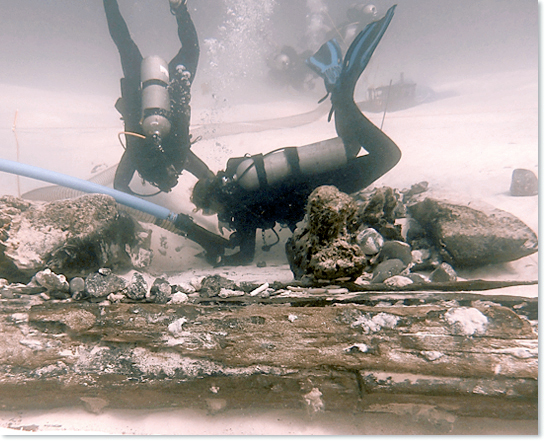IntroductionWelcome to the Pillar Dollar Wreck By Allyson Ropp

Students from previous field season (2014) dredging out a section of the Pillar Dollar wreck (photo by J. McKinnon 2014).
This summer, one of East Carolina University’s Program in Maritime Studies field schools will be traveling to Biscayne National Park to continue work on the Pillar Dollar Wreck Site. Six students—Sean Cox, Kristina Fricker, Trevor Hough, Dorothy Sprague, Olivia Thomas, and Annie Wright—will be traveling to Florida with their professor, Dr. Jennifer McKinnon, two crew chiefs—Kelsey Dwyer and Allyson Ropp—and their Diving Safety Officer, Jason Nunn, to spend three weeks excavating and mapping the site to add to the work that began in the Fall 2014 season.
The Pillar Dollar Wreck sits within Biscayne National Park in Homestead, Florida. Mention of the wreck first appeared in Martin Meylach’s (1971) Diving to a Flash of Gold. According to Meylach, in 1963 artifacts were taken from the site, including two cannon, Spanish pillar dollars, and slave bracelets. The pillar dollar coins dated to the shipwreck to the early 1760s. The site continued to be treasure hunted by at least three other groups which claimed little of “value” could be found on site. With the formation of the park in 1984, the site received semi-regular to regular condition assessments thereafter, some of which identified continuous looting and treasure hunting. In 2014, East Carolina Program in Maritime Studies conducted a survey and began excavations at the site to determine the vessel-type, period, and its cultural affiliation.
The 2014 survey and excavations revealed that the wreck likely ran aground on the nearby reef and was unable to recover. It may have been salvaged at the time of the wrecking as the wreck shows signs of burning, a common method used in the process of salvaging shipwrecks in the Florida Keys. No cultural identification as yet has been proposed for the site. Initially, it was thought the ship was Spanish-built due to the Spanish material culture collected by treasure hunters and archaeologically recovered in 2014; however, timber samples reveal that the ship was built of wood from the northeast of the Americas. Thus questions remain and a return to the site for more excavation could lead to more information.
The field season officially begins this week, with the students leaving May 23rd for Florida. This week will be spent organizing and packing all of the dive and archaeological gear, and learning about the previous work on the site and what to expect while excavating. In the course of packing the students will learn what equipment to take into the field and other important skills necessary for archaeological excavation projects. The most important thing they will learn is that….two is one and one is none!!...always pack spares of everything!!
Next

